Vinterpalatset A Story of Magnificence, Proud and Mourned |
This article first appeared in |
| Pictures and text by: Peter Andren, engineer, Sweden | Issue 51 - December 1997 |
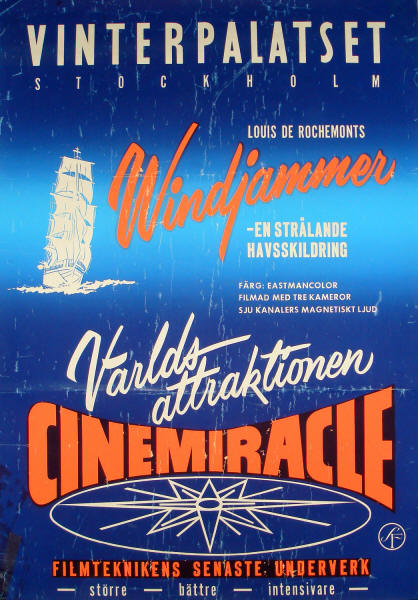 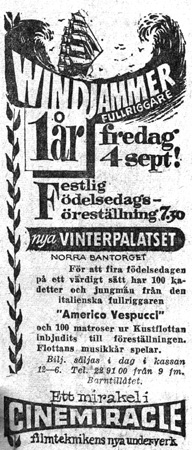 "Windjammer"
poster and advertising. Courtesy:
Bengt Norman, Film Collection 2006 "Windjammer"
poster and advertising. Courtesy:
Bengt Norman, Film Collection 2006This is the story of one of the greatest cinemas in Sweden. It was called "Vinterpalatset" ("The Winterpalace") and was situated in Stockholm, the lovely capital of Sweden. Mr. Andren has a long career behind him as a train engineer and projectionist. He is currently building his own 3-strip setup and expects to be able to show Cinerama in a few years. Mr. Andren is a technical consultant to a municipal film museum in Säterne, Sweden, and he is an expert on AGA, Bauer U2 and Philips FP2 projectors. The story of Vinterpalatset cinema ("VP" for short) can be traced back to the year 1914, when the "Auditorium" cinema opened. It was built on a foundation of an old gas storage tank, which resulted in the circular hall with a diameter of some 32 meters. The height to the ceiling was 16 meters at the highest point and it had 1751 seats. The Auditorium was used for concerts one evening a week, the remaining evenings for filmshows. In 1926 a remodeling increased the seating capacity to 1952 seats. During the thirties the filmshows gradually were dropped, and from 1942 onwards the Auditorium became a ballroom and exhibition hall. At this time the name was changed to Vinterpalatset. VP was owned by Mr. Carl Nelson, who at that time ran Royal Film AB, a cinema circuit with cinemas all over Sweden. In 1956 Mr. Nelson started investigations into the possibility of converting VP back to a cinema for the new Todd-AO system. The Philips company of Holland made up a set of drawings, and offered a complete projection system proposed. The projectors would be installed in a completely new projection room on the balcony, resulting in nearly level projection. The throw, 23,8 meters in combination with Cine-Apergon lenses of f=3" would result in a picture size of 15 x 6,87 meters. The depth of the screen was calculated to 2,4 meters. For unknown reasons this conversion was never carried out. In April 1958 the film "Windjammer", shot in the new Cinemiracle system, had its European premiere in Oslo, Norway. At this event, among others invited, Mr Nelson and representatives of Svensk Filmindustri AB (SF) met up. SF was, and still is, the leading cinema circuit in Sweden. This show must have been very impressive to them, as they immediately agreed to start a joint venture to bring this exciting form of entertainment to Sweden. Mr. Nelson, who by this time had sold his cinema circuit, immediately started negotiations with Robin International, the company marketing Cinemiracle outside the USA. Through his company Monark Film, he aquired the exclusive rights to show "Windjammer" in Sweden. At first it was meant that Draken, a very beautiful Stockholm cinema in the SF circuit would be utilized. Eventually this plan was abandoned and the VP was selected the best location. Construction work started in the beginning of July 1958 and included a new projection room on the balcony, new slanted floor in the circle, a gigantic screen frame in front of the old proscenium, and a complete refurbishing of the interior. The seating capacity became 913 seats. |
More in 70mm reading: |
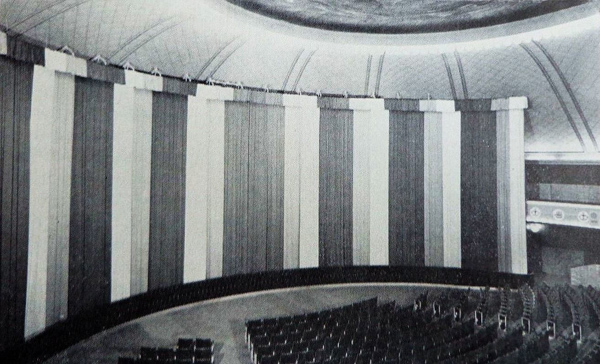 The screen frame was made of steel tube making up a curve being some 80
degrees of a circle. The screen size was 20,4 x 8,3 metres giving a picture
size of 20,1 x 7,9 metres. Remotely controlled maskings were applied to the
sides and top. In front of the screen, hung from of the top of the
screenframe, was a nice curtain in four colors. The seating was of the
latest design, providing superior comfort. The first rows were so close to
the screen that they were nearly inside the screen (curve). The screen frame was made of steel tube making up a curve being some 80
degrees of a circle. The screen size was 20,4 x 8,3 metres giving a picture
size of 20,1 x 7,9 metres. Remotely controlled maskings were applied to the
sides and top. In front of the screen, hung from of the top of the
screenframe, was a nice curtain in four colors. The seating was of the
latest design, providing superior comfort. The first rows were so close to
the screen that they were nearly inside the screen (curve).In the projection room the equipment consisted of 3 Century "G-1" Cinemiracle projectors on heavy duty bases. Both magazines were mounted on a floor stand underneath the projector head, eliminating for the projectionist the need to lift the heavy filmspools over their heads. The lower magazine had motor driven take ups. Ashcraft "Super Cinex" watercooled arclamps provided sufficient light when projected at 140 Amps. Because of the heat, even the gate assemblies in the projectors were watercooled. The lamps were modified to allow for longer running time necessary with Cinemiracle. The D.C. was supplied from 3 Gaumont Kalee 140 Amp rectifiers. For the prologue and commercials a standard Bauer 35mm projector was used. Originally water circulators were used for cooling water but they proved inadequate. The water was nearly boiling, so the circulators were eliminated and water was taken directly from the main supply. |
|
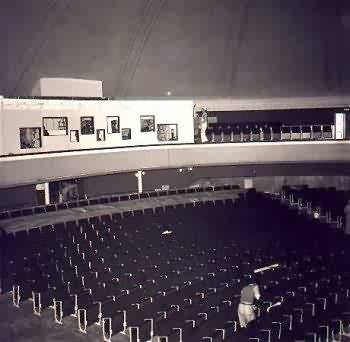 The sound system was RCA with a rated output of 60 W per channel, coupled to
a sound reader built by Stancil-Hoffman. For emergencies, the center
projector had a magnetic soundhead reading a soundtrack mixed down to mono.
It also read a 1,6 kHz control track for switching the surround channels. To
achieve synchronism of all projectors and the soundreader, selsyn
interlocking motors by General Electric were used. As the whole equipment
package was designed to be mobile, all connections between the apparatus
were carried out by means of plugs and rubbercovered cables, greatly
reducing the time required to assemble the lot. The sound system was RCA with a rated output of 60 W per channel, coupled to
a sound reader built by Stancil-Hoffman. For emergencies, the center
projector had a magnetic soundhead reading a soundtrack mixed down to mono.
It also read a 1,6 kHz control track for switching the surround channels. To
achieve synchronism of all projectors and the soundreader, selsyn
interlocking motors by General Electric were used. As the whole equipment
package was designed to be mobile, all connections between the apparatus
were carried out by means of plugs and rubbercovered cables, greatly
reducing the time required to assemble the lot.At the beginning there were 5 projectionists on duty. One at the center projector, the chief, checking the other projectors before the start (lacing up, carbons etc), starting and stopping the show, maintaining focus, carbon trim and sound operation, one projectionist at each side projector, maintaining focus, ranking (framing), carbon trim and mirrorposition. One projectionist at the soundreader, and one for rewinding and relieving other members of the crew when neccesary. Later the crew was reduced to 4 men. The whole installation was supervised by Mr. Samuel Bale, who also installed Cinemiracle in London, Munich and Denmark. Mr. Bale was very pleased with the VP installation, claiming it to be one of the best Cinemiracle cinemas in the world. Because of the circular shape, it was an excellent hall to adapt for Cinemiracle. VP also created some spinoffs, like the Cinerama Dome in Los Angeles. |
|
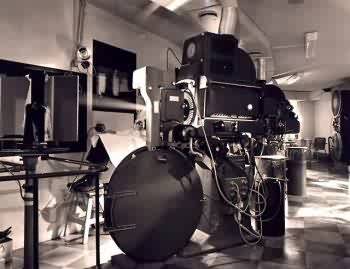 On September 4, 1958, the grand opening was held with a lot of honoraries
attending. "Windjammer" became a great success, running for
an amazing 20 months to full capacity. On September 4, 1958, the grand opening was held with a lot of honoraries
attending. "Windjammer" became a great success, running for
an amazing 20 months to full capacity.By the beginning of 1959, a pair of Philips DP70 projectors were ordered for VP, making it possible to show Todd-AO as well as ordinary 35mm films. However, the DP70s were never installed since "Windjammer" did so well over such a very long time. Instead it was decided to switch to Cinerama. In the spring of 1960, an engineer arrived in Stockholm for the modification of the Cinemiracle projectors to Cinerama. The major work was to install the jiggolos in the gates. The conversion was carried out during the day, one head at a time, eliminating the cancelling of any shows. The first Cinerama show was held on June 13, 1960 when "Seven Wonders of the World" had its premiere. From this point on, all 7 Cinerama films were shown, as well as 2 re-runs of "Windjammer" and one Russian Kinopanorama film ("Great is My Country"). By 1964 it was obvious that no more films would be made in the 3-panel system and it was decided to go for 70mm. Cinerama in England insisted on using Cinemeccanica Victoria 8 projectors, since they could be converted for 70mm as well as Cinerama and standard 35mm film. Both Victoria 8s received were second hand projectors, probably from England. The RCA sound equipment was retained although an amplifier rack from Cinemeccanica was supplied along with the projectors. Also the Ashcraft lamphouses were retained. |
|
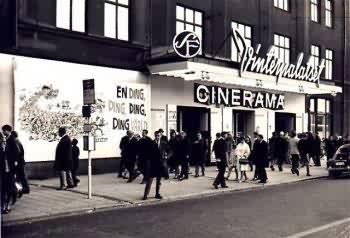 The first 70mm show was held on November 11, 1964 when the film "It's
a Mad, Mad, Mad, Mad World", filmed in
Ultra Panavison
70 had its
Swedish premiere. Specially calculated lenses by Cinerama, Inc. were used to
fill the big screen but it was impossible to achieve a sharp picture. This
led to massive complaints from the audience. A Philips DP70 projector was
installed temporarily for testing but the result was only slightly better.
After a while, two second hand Cinemeccanica lamps were installed on the
Victoria 8s. This, combined with
Philips BF
lenses solved the problem. The
optical alignment between the Cinerama arcs and the V8 were not compatible
for 70mm projection. The picture size for standard 70mm film, Todd-AO, was
set to 7,8 x 17,23 meters. The Cinemiracle equipment was dismantled and put
into storage, except for the soundreader, its built-in magnetic preamps
still in use. Later on, they were removed and placed in a box on the front
wall of the projection room. The Cinerama soundreader went into storage. The first 70mm show was held on November 11, 1964 when the film "It's
a Mad, Mad, Mad, Mad World", filmed in
Ultra Panavison
70 had its
Swedish premiere. Specially calculated lenses by Cinerama, Inc. were used to
fill the big screen but it was impossible to achieve a sharp picture. This
led to massive complaints from the audience. A Philips DP70 projector was
installed temporarily for testing but the result was only slightly better.
After a while, two second hand Cinemeccanica lamps were installed on the
Victoria 8s. This, combined with
Philips BF
lenses solved the problem. The
optical alignment between the Cinerama arcs and the V8 were not compatible
for 70mm projection. The picture size for standard 70mm film, Todd-AO, was
set to 7,8 x 17,23 meters. The Cinemiracle equipment was dismantled and put
into storage, except for the soundreader, its built-in magnetic preamps
still in use. Later on, they were removed and placed in a box on the front
wall of the projection room. The Cinerama soundreader went into storage.The years went by. VP ran many nice 70mm films but in the early 70s it was decided to put the 3-panel system back for a selected re-run. All the equipment was once more installed and aligned, only to reveal that prints of "Windjammer" and "This is Cinerama" were badly faded. "How The West Was Won" still had excellent color. "Windjammer" and "This is Cinerama" could not be shown to the public. What a disappointment. Projection equipment went back to the storage room. Now commenced a time of 70mm re-runs but in the mid 70´s VP fell victim to standard 35mm anamorphic even if it was not as good because it was too grainy. |
|
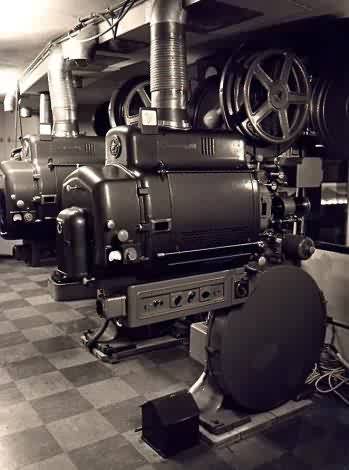 Everything must come to an end, even so for Vinterpalatset. In 1977 it was
announced that Sweden's largest union had acquired the site to build an
office block. The last performance was to be held on December 31, 1977.
Despite several attempts, it was not possible to save this magnificent
cinema that had become a legend in its own time. Everything must come to an end, even so for Vinterpalatset. In 1977 it was
announced that Sweden's largest union had acquired the site to build an
office block. The last performance was to be held on December 31, 1977.
Despite several attempts, it was not possible to save this magnificent
cinema that had become a legend in its own time.During the last 6 weeks, a cavalcade of VP's best films were held, giving the people of Stockholm a last chance to once again see their favorite film on the big screen. Included were, among others, a 70mm print of "How the West Was Won". The last public performance started 7 pm December 31, 1977; the film was "Earthquake" in SENSURROUND. *) The following day a party for all employees and the management was held. Of course there must be some screening on such an event and so "The Miracle of Todd-AO" was screened. As a souvenir, small pieces were cut from the screen and handed over to everyone. During the next weeks the cinema was cleared of all equipment, seating, decorations etc., and within a few more days the building was demolished. The story of Vinterpalatset had come to its end. Vinterpalatset was a truly magnificent cinema, having a very fine interior, big screen, excellent projection and very attractive film programming. Former staff are very proud to have worked in this renowned cinema and its closing down is mourned by them as well as by many of its spectators who went to see a film there. Even now, 20 years after the closure, it is not unusual to meet people who clearly recall their visits to VP and the experience they witnessed when "Windjammer" or any other great film swept across the vast screen. |
*) It was a 35mm print of "Earthquake" in Sensurround which was shown, 31/12 1977 kl. 6.45. The premiere of "Earthquake" in Sensurround was in 70mm. The Vinterpalatset was considered one of the worlds finest Sensurround cinemas. Bengt Norman photographer, and projectionist at the Vinterpalatset, Stockholm, Sweden July 31, 2002. |
|
Go: back
- top - back issues Updated 22-01-25 |
